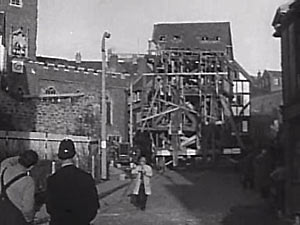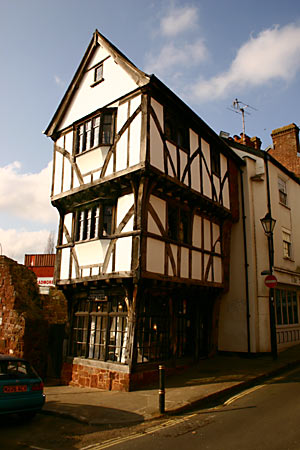
Exeter Stories
Exeter folk and friends in their own words - 1890's to the 1990's │ << Previous story │ Next story >> │
Also see: House that Moved - history and photo essay
Dick Passmore - Watching the House that Moved
It had never happened in Exeter before, and it seemed as if the whole city wanted to be part of the historic occasion. A house was to be jacked up and rolled along the street on rails to a new location. Thousands of people – not only Exonians – personally witnessed the event, and of course the local and national press were having a field day!
It was an experience that would probably never happen again, and to be there was something that would be etched in one’s memory for ever. For several days engineers had encased the house in a timber cradle, to keep it rigid. That alone was fascinating to watch. The timbers required to form the cradle in 1961 probably cost more than the original house! Then came the moment when the house was to be jacked up and placed on wheels, ready to be moved. The technique of negotiating the house on to a set of rails was almost impossible to comprehend – yet there it was for all to see. No. 16 Edmund Street was about to change location!
No doubt many of the public were waiting for that dreaded moment when it all fails, and the whole thing collapses; their wait was in vain, and the house started its move towards Stepcote Hill, up a gradient said to be 1 in 10. Traffic had been diverted to allow the operation to take place, and Edmund Street unusually became a quiet thoroughfare, the only noise being the instructions shouted by the engineers in charge, the creaking of the winch and the soft buzz of the inquisitive daily crowds who wanted to see how it was done.
Even before being moved, the house looked incredibly fragile, having been derelict for years. It was, however, far stronger than many imagined, and experts declared the whole building a moveable item. Watching the team prepare the house, get it on to wheels and start the move was an incredible experience. Whilst the area was cordoned off, it was possible for the public to watch – some twenty or thirty yards away from the building. Some, like myself, were even more fortunate to be even closer, for I was at that time a young police constable, one of several who were seconded to the area each day, to ensure the public were kept at a distance, and that nothing interfered with the progress of the engineers.
To be able to watch the move at close quarters was a privilege, made even more interesting as the engineers willingly explained what they were doing – and why – as they went about their mammoth task. This was not the first time they had carried out a “house move”, and they were totally confident. Their almost nonchalant air of confidence was impressive – and they were, of course, right, as the whole operation went incredibly smoothly. Every inch along the move was checked and re-checked. Nothing moved until an instruction was given, and eventually 16 Edmund Street took up a new position in West Street – on the site that once housed an almost identical property, demolished as being unsafe in the 1940s.
The House That Moved has become one of Exeter’s landmarks; the story of its move continues to fascinate both residents and tourists alike. To have been part of that occasion and witnessing the move, if merely an onlooker, was a moment in one’s life that will always be remembered.
© 2006 Dick Passmore - David Cornforth
Dick Passmore was a young police constable when the House that Moved was moved, and was present at the event. Dick who is now retired, is the author of The Story of the Theatre Royal, published by Stevens Books.
 The
House that Moved 1961
The
House that Moved 1961
9.5 MB WMV BBC Creative Archive
 A police colleague of Dick Passmore watches the manouvering of the
house. Still from a BBC film under the Creative Archive scheme.
A police colleague of Dick Passmore watches the manouvering of the
house. Still from a BBC film under the Creative Archive scheme.
 The House that Moved after
restoration.
The House that Moved after
restoration.
│ Top of Page │